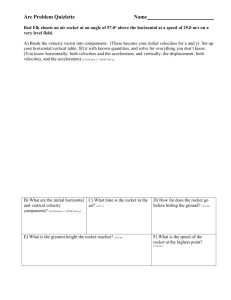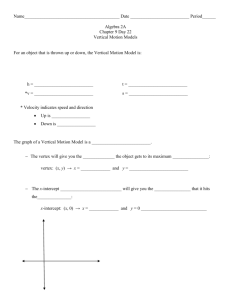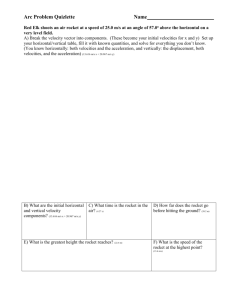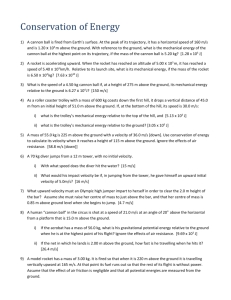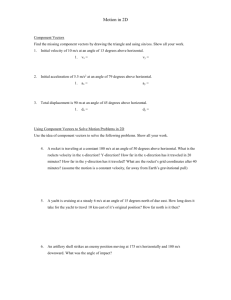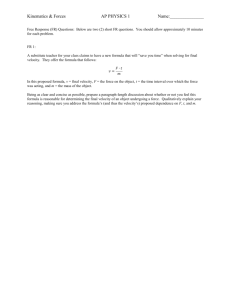Solutions to Mechanics Problems
advertisement
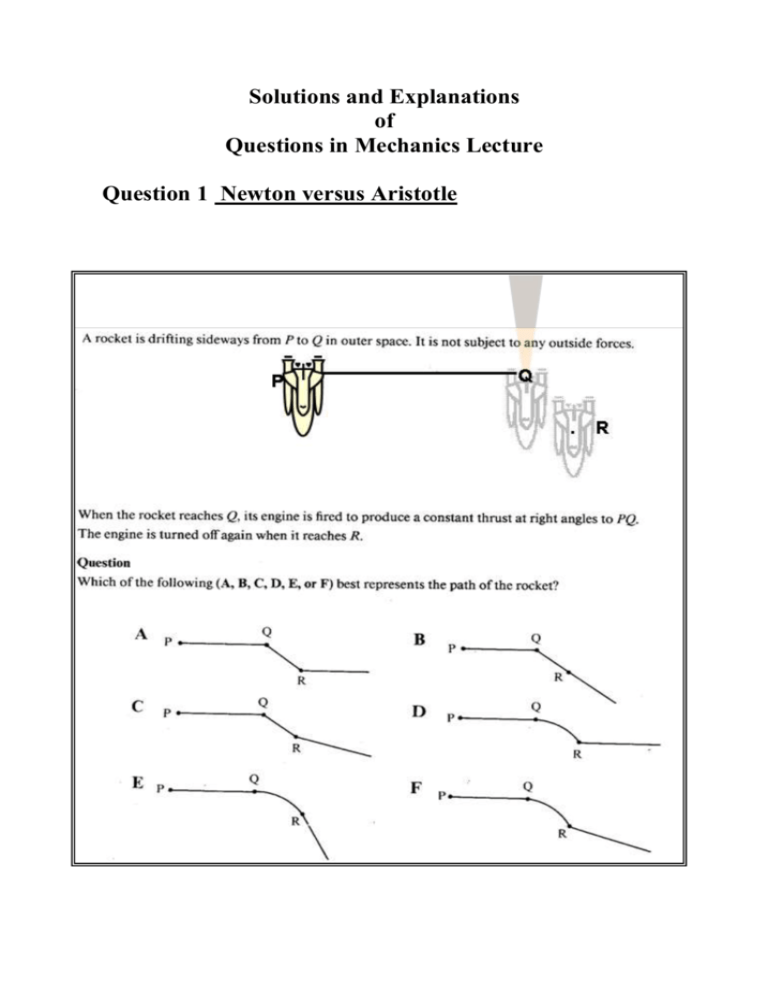
Solutions and Explanations of Questions in Mechanics Lecture Question 1 Newton versus Aristotle The Conditions The rocket is in outer space, so there is no gravitational force on it, in fact there is no force acting on it. The rocket is moving at constant velocity. These conditions immediately separate the Aristotelian and Newtonian models of mechanics. The consequences The Aristotelian view is: "if a body is moving, there must be a force causing this motion" Thus: from P to Q there is a horizontal force pushing the rocket. from Q to R there is an additional downward force due to the engine from R onward the original horizontal force still acts . The Newtonian view is " a body remains at rest or moves at constant velocity unless it is acted on by a force" Thus: From P to Q there is no force on the rocket, it moves at constant velocity From Q to R the only force acting on the rocket is the downward one due to the engine. After R there is no force acting on the rocket, so it continues with whatever velocity it had at R Analysing the options Option A Students choosing this option believe entirely in the Aristotelian view. From P to Q there is a horizontal force acting to keep the rocket moving at constant vel. From Q to R this is joined by a vertical force that adds a vertical motion at constant velocity. Hence a linear motion at an angle. From R onward, only the Horizontal force acts, so the rocket reverts to constant horizontal motion. Option B The logic here is exactly as for option A. Aristotelian mechanics holds, except that for some unknown reason, the rocket maintains its final motion after the engine turns off. there is now a force, according to this logic, acting at some 45o downward. This option involves a strange mixture of Newtonian and Aristotelian mechanics Option C The logic here is the same as for Option B, except that the student is not sure whether the motion returns to that of option A or option B. Option D This option is a strange mix of the two views of mechanics. The motion from Q to R is consistent with Newton. A constant force vertically would lead to a displacement that increased as (time)2: hence the parabolic trajectory. We could then assume that the student knew that there was no force acting on the rocket from P to Q. However after R, the rocket reverts to its original motion rather than continuing in the direction it was travelling when the rocker turned off. This suggests that the student thought that there WAS a horizontal force acting from P to Q, and this is still acting after R. Option E (This is the correct answer) There is no force acting from P to Q, so the rocket moves at constant velocity until the engine goes on. Now the displacement is increasing at a constant rate horizontally, and increasing as (time)2 vertically, leading to the parabolic motion (Same as projectile motion under gravity). When the rocket force disappears, there is no force on it, and the rocket continues at constant velocity in the direction it had when the engine turned off. Option F The student who chooses this appears to believe Newton, as for option E. However this student is unsure as to what happens when the rocket force disappears, and chooses a compromise between final motion as for option E, and options D or A. Question 2 Frames of Reference The Conditions It is assumed that: air resistance is negligible the runner moves at constant velocity the ball falls under gravity The intent of the question The aim is to check whether Aristotelian concepts still predominate, and to confirm the understanding of Newtonian mechanics, viz that if there is no force acting on a body, its state of motion will not change: if at rest it will remain at rest, if moving it will continue to move with that same velocity. Analysing the options Option A Choice of this option, where the ball falls where it was released by the runner, implies that the subject believed that the ball was moving because it was being driven by a force from the runner (Aristotelian belief). When released there was no horizontal force, and the ball ceased to move horizontally, and fell vertically under the gravitational force. Option B Choosing this option suggests that the candidate realises that the ball has some momentum when released, but that it dissipates as it falls under gravity. It may be, if it has not been stressed initially that air resistance can be ignored, that the candidate has the correct understanding, but assumes that air resistance is responsible for it falling to the ground sooner than in the correct picture (option 3). In reality air resistance could not produce such a marked loss of horizontal velocity. Option C This is the correct option. Both the ball and the runner are moving with the same velocity, and hence can be considered to be in the same inertial reference frame, which is at rest. There is no horizontal force acting, so according to Newtonian mechanics the initial velocity of the ball when it is released (which is the same as the velocity of the runner) never changes. Thus when the ball reaches the floor, and the photo is taken, it is at the feet of the runner. An equivalent analysis sees the ball and runner each at rest in individual reference frames that are moving at the same constant velocity. Question 3. Newtonian Action and Reaction Pairs Newton’s 3rd law states that for every action (force), there is an equal and opposite reaction (force). Thus, if I push on a block, the block will push back on me with an equal and opposite force. Note that the two forces act on different objects. I push on the block, the block pushes on me. Many people forget that Newton’s action and reaction forces act on different bodies, and this is the point of the situation above. Block A, sitting on the table, has a weight force of W = mg pulling it due to the mass of Earth. A common mistake is to conclude that the reaction to the weight force of block A is the normal reaction, N, of the table acting on block A. This is incorrect! Both these forces act on the same body, viz block A. The reaction force of the weight of Block A is the gravitational force that block A exerts on Earth (indicated by the force W’). This force in essence acts at the centre of Earth. These forces are equal and opposite, and act on different bodies. To complete the picture, the Newtonian pair of the normal reaction N that acts on block A, is the force, N’, of the block acting on the table. In the case of block B, which is in free fall, it is clearer that the Newtonian reaction pair to its weight, W = mg, is the gravitational force N’ that the block exerts on Earth. Question 4: Bodies Falling under Gravity The conditions Three heavy, compound objects, 1, 2, and 3, are held stationary as shown in the top left-hand figure. Each object consists of a heavy part (A) and a lighter part (B), either rigidly joined (objects 1 and 2), or joined by a string (object 3). All three objects are released simultaneously, and fall to the ground under gravity. Figures A, B, and C illustrate the possible orientations of the objects as they reach the ground. Which of these best represents the true situation? The intent of the problem The Aristotelian view that heavy objects fall faster than light objects is attractive, and many people subscribe to this. It is simple to show this belief to be false, and all objects fall under gravity with an acceleration of "g": Analysing the options Option A People choosing this option assign some kind of stability to the heavy component A, with mass B providing an imagined turning torque. Thus for object 1, the rigidly attached mass B is imagined to produce an anti-clockwise rotation of the entire object. There being no such imagined turning-moment acting on object 2, it falls straight down. For object 3, this imagined turning torque on mass A, due to mass B that is now attached by a string, rotates mass A clockwise. Option B This is the correct option Each component of the objects is acted on by gravity, and each falls with acceleration "g", as Newton requires. Thus the orientation of each object does not change. Option C People who choose this option are thinking, like Aristotle, that heavy objects fall faster than light ones. Hence object 1 appears to rotate clockwise since mass A falls faster than mass B. Object 2 falls straight down since mass B is directly under mass A and is rigidly coupled. For object 3, mass A, being heavier falls more quickly than mass B, and can catch up since they are only coupled by string.
